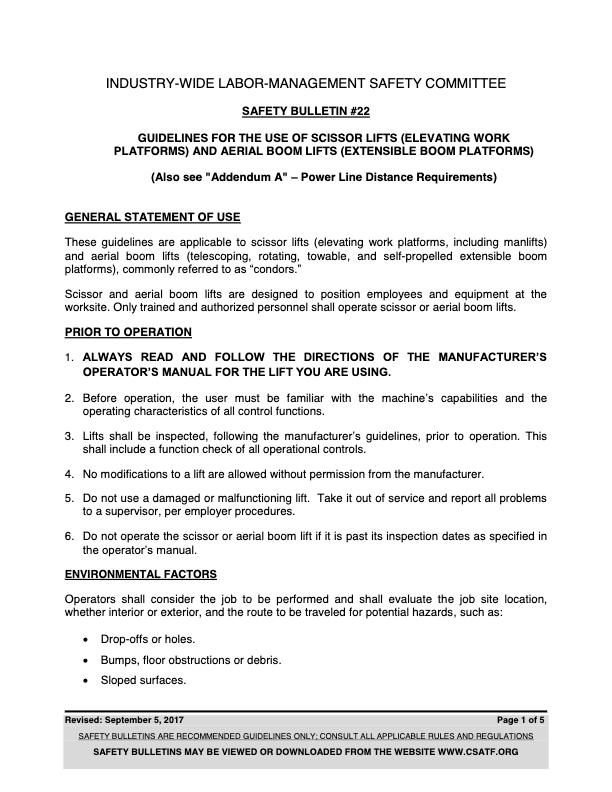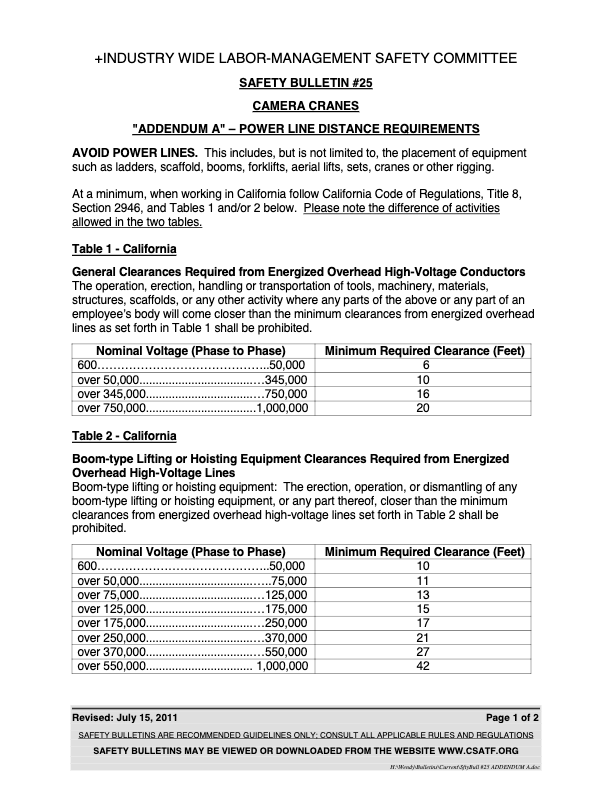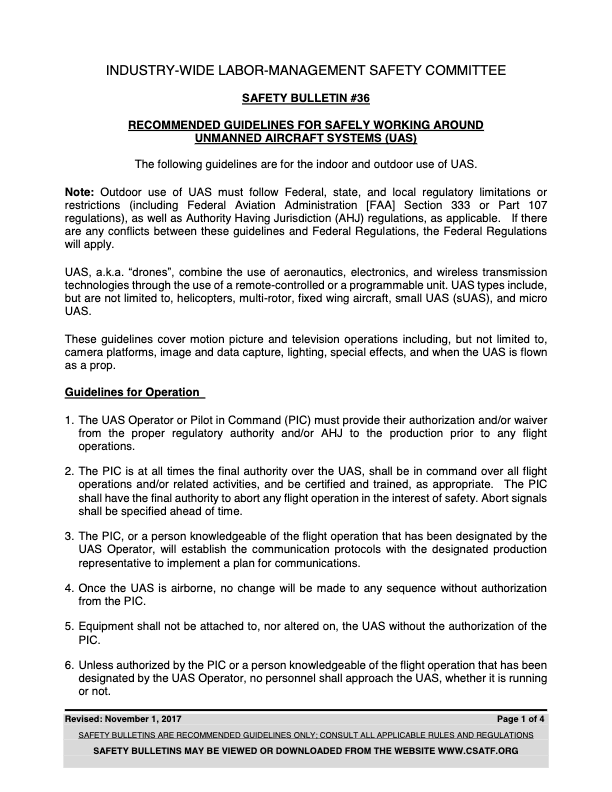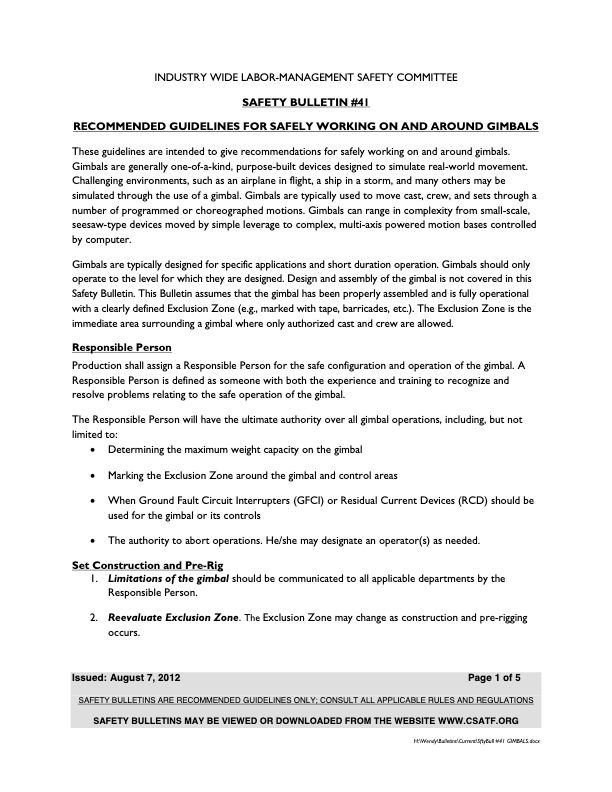Safety Bulletin

Guidelines
These guidelines are applicable to scissor lifts (elevating work platforms, including manlifts) and aerial boom lifts (telescoping, rotating, towable, and self-propelled extensible boom platforms), commonly referred to as “condors.”
Scissor and aerial boom lifts are designed to position employees and equipment at the worksite. Only trained and authorized personnel shall operate scissor or aerial boom lifts.
PRIOR TO OPERATION
- Always read and follow the directions of the manufacturer’s operator’s manual for the lift you are using.
- Before operation, the user must be familiar with the machine’s capabilities and the operating characteristics of all control functions.
- Lifts shall be inspected, following the manufacturer’s guidelines, prior to operation. This shall include a function check of all operational controls.
- No modifications to a lift are allowed without permission from the manufacturer.
- Do not use a damaged or malfunctioning lift. Take it out of service and report all problems to a supervisor, per employer procedures.
- Do not operate the scissor or aerial boom lift if it is past its inspection dates as specified in the operator’s manual.
ENVIRONMENTAL FACTORS
Operators shall consider the job to be performed and shall evaluate the job site location, whether interior or exterior, and the route to be traveled for potential hazards, such as:
- Drop-offs or holes.
- Bumps, floor obstructions or debris.
- Sloped surfaces.
- Unstable or slippery surfaces.
- Overhead obstructions and high voltage conductors.
- Hazardous environments.
- Inadequate support of the surface bearing the load imposed by the machine, such as the capacity of the ground, decks, floors, pit covers, and stages.
- Wind and weather conditions.
- The presence of unauthorized personnel.
- Other possible unsafe conditions.
GUIDELINES FOR OPERATION
- Enter and exit only through the gate entry area. Make sure the scissor arm assembly or aerial lift boom arm is fully lowered in the stowed position. Use extreme caution when entering or leaving the platform; always face the machine or ladder. Always maintain “three points of contact” (two hands and a foot or two feet and a hand) at all times when climbing or entering/exiting the lift.
- Guardrails are the only fall protection required by OSHA in a scissor lift, but some manufacturers recommend and some employers require the additional use of personal fall protection attached to an approved anchor point by all occupants in the platform. Always check manufacturer and employer guidelines.
- In addition to guardrails, personal fall protection is required in an aerial boom lift for all occupants in the platform. Everyone in an aerial boom lift must wear a full body harness with a fall restraint or fall arrest lanyard of the appropriate length attached to a designated anchor point in the platform. Always check manufacturer and employer guidelines.
- Do not operate a scissor or aerial boom lift unless the guardrails are properly installed and the entry is secured. Attach the platform entry chain, lower the platform mid-rail, or close the entry gate before operating.
- Attaching personal fall protection equipment to an adjacent pole, structure or equipment while working in a scissor or aerial boom lift is not permitted.
- Do not sit, stand or climb on the platform guardrails nor use planks, boxes, ladders or other devices to gain greater working height or reach. Never climb up or down the boom arm or scissor arm assembly. Maintain a firm footing on the platform floor at all times. Keep the platform floor clear of debris, oil, and mud. Keep slippery substances off of footwear.
- Operate all controls slowly to ensure smooth platform movement. Make sure there is sufficient clearance around the scissor or boom lift before moving the chassis, boom, or platform.
- Scissor and aerial boom lifts are designed to be used on “firm level surfaces only.” No lift shall be used on an inclined surface unless designed and allowed for such use by the manufacturer. Operation of lifts on inclined surfaces shall NOT exceed manufacturer’s ratings.
- Provided they can safely be installed, wheel chocks shall be used on inclined surfaces. The braking system shall be set when elevating employees and when wheel chocks are used. Never leave the lift unattended if you have stopped it on a ramp, grade or incline until you have chocked at least one tire. Note: Lifts may creep on an incline even if the brakes are set. Avoid stopping or turning on a grade if possible.
- The platform shall NOT be loaded beyond its rated capacity.
- Tools or equipment, which could fall from the aerial platform, must be secured.
- Aerial boom lift baskets or platforms shall NOT be supported by adjacent structures when anyone is in the basket or platform in an elevated position.
- When used, outriggers must be placed on a firm surface.
- When there are moving vehicles or pedestrian traffic, secure the work area around the lift with flags, traffic cones, caution tape, or other means of traffic control.
- Unauthorized personnel should not work, stand, or walk under a raised boom or platform.
- Do not use a lift as a welding ground unless the unit has a welding grounding connection. Refer to the manufacturer’s manual for grounding information.
- Do not use a scissor or aerial boom lift as a crane.
- Do not attempt to raise the platform/basket beyond its rated maximum height or reach.
- Lifts should be driven with the platform in the lowest drivable position as recommended by the manufacturer. Driving with an operator in an elevated position is allowed (with employer approval) if the operator has a clear view of travel or spotters are used; the driving surface is level, firm, and smooth; and the lift is operated at no more than the speed allowed by the manufacturer based on the elevation of the boom arm.
- When moving a scissor or aerial boom lift, position yourself on board the platform, and then conduct all moving operations from that position. Lifts, when in operation, are to remain solely under the control of the operator in the platform. Switching controls and moving the equipment in any manner without the consent of the operator while the operator is in the platform is prohibited except in case of an emergency. Exception: On certain models of smaller scissor lifts, the platform control panel can be disconnected and relocated at the base of the lift in order to move the lift through an area of limited clearance such as a doorway. If doing so, make sure to follow the manufacturer guidelines, including:
- Clearing the path of travel of people and equipment.
- Positioning yourself behind the platform.
- Announcing that the lift will be moving.
- Driving at as low a speed as practical.
- Using a spotter to guide movement (ensuring the spotter remains at a safe distance).
- When moving a lift forward, do not engage REVERSE until the vehicle has come to a complete stop. Changing direction is not the proper means of braking a lift.
- Use REVERSE only as an emergency measure if the lift continues to crawl forward after releasing the drive-control joystick to the neutral passive-stop position.
- Use FORWARD only as an emergency measure should the equipment continue to crawl in reverse after releasing the drive-control joystick to the neutral passive-stop position.
POWER LINES
- Scissor and aerial boom lifts shall not encroach within the minimum safe approach distance (MSAD) as listed in Safety Bulletin #22 “Addendum A” Power Line Distance Requirements of any energized overhead power line unless danger from accidental contact with that energized line has been effectively guarded against. Note: Your employer may choose to set greater clearance requirements than those listed in Safety Bulletin #22 “Addendum A.”
- Use caution when working near lines of lower voltage.
- Aerial lifts rigged with electrical lighting, special effects, or grip equipment should not be operated over low voltage electrical utility lines (600 volts or less), including supply lines for residences.
- The operation of scissor or aerial boom lifts OVER energized, high-voltage lines of any sort is prohibited at all times.
- Some employers may also prohibit working under power lines. Consult with your employer or studio safety representative for more information if there are questions or concerns regarding working around power lines.
ADDITIONAL CONSIDERATIONS
No scissor or aerial boom lift shall be raised, nor shall personnel be in the work lift platform or basket when any of the following conditions exist:
- Extreme weather conditions exist (lightning, heavy rain, hail); or
- Accumulation of ice or snow on the platform; or
- Winds exceed 25 miles per hour.
Note: There may be lower wind speed limits when performing additional activities such as those covered in the rigging and cribbing supplemental manuals.
RIGGING AND CRIBBING FOR AERIAL BOOM LIFTS ONLY
- Within manufacturers’ defined limits for specific models of aerial boom lifts; lighting, camera, and diffusion equipment may be rigged onto guardrails or beyond the platform of an aerial boom lift; in such case additional training is required.
- Consult the manufacturer’s operator’s supplemental manual for authorized and trained set lighting technicians and studio grips, for instruction and list of approved models. If the manufacturer does not provide a supplemental manual or manufacturer approval, do not rig equipment onto guardrails or beyond the platform of an aerial boom lift.
- Within manufacturers’ defined limits for specific models of aerial boom lifts, cribbing can be used to create a level surface. Specific drive/steer disable lockout switches and cribbing platforms are required for this procedure. Training is required for the construction and use of such cribbing.
- Consult the manufacturer’s supplemental cribbing manual for instruction and list of approved models. If the manufacturer does not provide a supplemental cribbing manual or manufacturer approval, do not use cribbing with the aerial boom lift.
- Consult the manufacturer’s supplemental cribbing manual for instruction and list of approved models. If the manufacturer does not provide a supplemental cribbing manual or manufacturer approval, do not use cribbing with the aerial boom lift.
RIGGING FOR SCISSOR LIFTS ONLY
All equipment must be rigged and secured on the platform inside of the guardrails.
- If the manufacturer does not provide written guidelines, do not rig equipment onto guardrails or beyond the platform, nor use cribbing.
The information contained in this bulletin is intended for use only as guidelines. Refer to the manufacturer’s operating manual for each specific make and model of lift you operate. Operational differences, location of controls, safety devices, and load capacity may vary for each model or equipment manufacturer.






